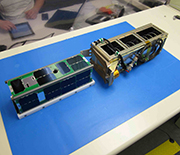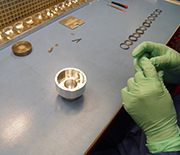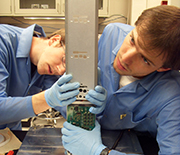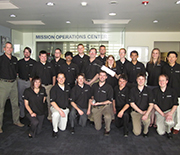News Release 17-119
Six-decade-old space mystery solved with shoebox-sized satellite called a CubeSat
Charged particles in Earth’s inner radiation belt created by cosmic rays born from supernova explosions

Researchers test the CubeSat, which is communicating with a ground station about four miles away.
December 13, 2017
This material is available primarily for archival purposes. Telephone numbers or other contact information may be out of date; please see current contact information at media contacts.
A 60-year-old mystery about the source of energetic, potentially damaging particles in Earth's radiation belts has been solved using data from a shoebox-sized satellite built and operated by students. The satellite is called a CubeSat.
Imagine a fully instrumented satellite the size of a half-gallon milk carton. Then imagine that milk carton whirling in space, catching never-before-seen glimpses of atmospheric and geospace processes.
CubeSats, named for the roughly 4-inch-cubed dimensions of their basic building elements, are stacked with smartphone-like electronics and tiny scientific instruments.
Built mainly by students and hitching rides into orbit on NASA and U.S. Department of Defense launch vehicles, the small, low-cost satellites have been making history.
Now, results from a new study using CubeSats indicate that energetic electrons in Earth's inner radiation belt -- primarily near its inner edge -- are created by cosmic rays born from supernova explosions, said scientist Xinlin Li of the University of Colorado Boulder (CU Boulder).
Earth's dual radiation belts, known as the Van Allen belts, are layers of energetic particles held in place by the planet's magnetic field.
Soon after the discovery of the Van Allen radiation belts in 1958, American and Russian scientists concluded that the process of "cosmic ray albedo neutron decay" (CRAND) was likely the source of the high-energy particles trapped in Earth's magnetic field. But over the following decades, no one successfully detected the corresponding electrons that should be produced during the neutron decay.
Li's team showed that during CRAND, cosmic rays entering Earth's atmosphere collide with neutral atoms, creating a splash that produces charged particles, including electrons, that become trapped by Earth's magnetic field.
The findings have implications for understanding and better forecasting the arrival of energetic electrons from space, which can damage satellites and threaten the health of space-walking astronauts, said Li.
"We are reporting the first direct detection of these energetic electrons near the inner edge of Earth's radiation belts," said Li. "We have finally solved a six-decade-old mystery."
A paper presenting the findings is published in this week's issue of the journal Nature. Li is the lead author. The study was funded by the National Science Foundation (NSF).
"These results reveal, for the first time, how energetic charged particles in the near-Earth space environment are created," said Irfan Azeem, a program director in NSF's Division of Atmospheric and Geospace Sciences, which supported the research. "The findings will significantly improve our understanding of the Earth-space environment. It's exciting to see NSF-funded CubeSats -- built by undergraduate and graduate students -- at the center of a significant scientific discovery."
The CubeSat mission, called the Colorado Student Space Weather Experiment (CSSWE), housed a small telescope to measure the flux of solar energetic protons and Earth's radiation belt electrons.
Launched in 2012 aboard an Atlas V rocket, CSSWE involved more than 65 students and was operated for more than two years from a ground station on the roof of a building on the CU-Boulder campus.
Part of the work of CSSWE involved building a smaller version of an instrument developed by a CU-Boulder team led by Nature paper co-author Daniel Baker and launched on NASA's 2012 Van Allen Probes mission. The modified instrument is called the Relativistic, Electron and Proton Telescope integrated little experiment (REPTile).
"This is really a beautiful result and a big insight derived from a remarkably inexpensive student satellite, illustrating that good things can come in small packages," said Baker. "It's a major discovery of what has been there all along, a demonstration that Yogi Berra was correct when he remarked, 'You can observe a lot just by looking.'"
Other Nature paper co-authors include researchers Hong Zhao and Kun Zhang of CU Boulder; Richard Selesnick of the Air Force Research Laboratory at Kirtland Air Force Base in New Mexico; Quintin Schiller of NASA's Goddard Space Flight Center in Greenbelt, Maryland; and Michael Temerin of the University of California, Berkeley.
-NSF-
-
The CubeSat just before it was brought into the launch facility.
Credit and Larger Version -
Assembling the only science payload onboard; it sent back high-quality data, researchers report.
Credit and Larger Version -
Integrating parts of the CubeSat, a process that was performed largely by students.
Credit and Larger Version -
Students enrolled in a geospace science course during which the CubeSat mission was developed.
Credit and Larger Version
Media Contacts
Cheryl Dybas, NSF, (703) 292-7734, email: cdybas@nsf.gov
Jim Scott, University of Colorado Boulder, (303) 492-3114, email: jim.scott@colorado.edu
The U.S. National Science Foundation propels the nation forward by advancing fundamental research in all fields of science and engineering. NSF supports research and people by providing facilities, instruments and funding to support their ingenuity and sustain the U.S. as a global leader in research and innovation. With a fiscal year 2023 budget of $9.5 billion, NSF funds reach all 50 states through grants to nearly 2,000 colleges, universities and institutions. Each year, NSF receives more than 40,000 competitive proposals and makes about 11,000 new awards. Those awards include support for cooperative research with industry, Arctic and Antarctic research and operations, and U.S. participation in international scientific efforts.
Connect with us online
NSF website: nsf.gov
NSF News: nsf.gov/news
For News Media: nsf.gov/news/newsroom
Statistics: nsf.gov/statistics/
Awards database: nsf.gov/awardsearch/
Follow us on social
Twitter: twitter.com/NSF
Facebook: facebook.com/US.NSF
Instagram: instagram.com/nsfgov




